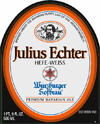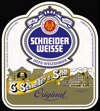Grain of Paradise
The now-popular hefeweizen needs little introduction to other than the most novice beer lover. The rebirth it has experienced, especially in the past 20 years, has ensured that nearly anyone interested in broadening their sense of beer appreciation has tried several.
Dunkelweizen is the dark version of hefeweizen, and is essentially identical except for the inclusion of some dark malt, and an attendant depth of flavor. In fact, dunkelweizen might even be more like the pre-Schnieder weizenbiers, as pale was a relative term up until the early 19th century. The flagship brew, Schnieder Weisse Original, continuously-brewed since 1872, has a rusty cast that is a window into the hefeweizens of several generations ago.
Most dunkelweizens will specify it on the label, just as it is assumed that a hefeweizen is a golden brew without stating it. The well-textured hefe and dunkel versions, brews that have not been stripped of their yeasty allure, are the authentic representatives of German beer in one of its most natural states.
By law, a German hefe or dunkelweizen must contain at least 50% malted wheat, but some may have as much as 70%. The remainder of the grist is, of course, barley malt. Hefeweizen would rely primarily on pilsner malt, while dunkelweizen might include Vienna, Munich or a caramunich variety for color, maltiness and complexity. Both are sparingly hopped, for bitterness only.
Fermentation is carried out with the inimitable Bavarian weizen yeast, one that sparks an aromatic and flavorful mix of vanilla, clove, bubblegum, banana or other spicy and fruity notes. The wheat itself lends a grainy, fresh bread character when combined with the yeast impression. Dunkelweizen would show off a bit of caramel and a light maltiness. The finish is tart, dryish and, owing to the chewy yeast and protein-rich wheat, paradoxically medium-bodied. All of this in a quenchingly modest strength of 5.0% ABV, give or take.
They are bottle-conditioned, either with the primary strain or a secondary lager strain to provide stability, and pour with a vigorous head. A proper half-litre weizen glass will corral their spirited personality. Many of the famous German breweries export them, as do some smaller ones, and they tend to travel well. American brewers are likely to replicate rather than Americanize them, and usually offer them as a seasonal. The dunkels are every bit as refreshing as the hefes.
The beer world may be more varied and exhilarating than ever, but there are some styles that never seem to entirely fade away, and are at some point enthusiastically embraced for their traditionalism or natural condition. Such are the weizenbiers of Bavaria. As the sultriness of summer arrives, they summon. Their refreshing, effervescent character is just the remedy for a lazy afternoon.















